Development of a Donkey Grimace Scale to Recognize Pain in Donkeys (Equus asinus) Post Castration
Abstract
Simple Summary
Abstract
1. Introduction
2. Materials and Methods
2.1. Animal Sample
2.2. Photo Set and Selection Protocol
2.3. Anesthesia and Surgery Protocol
2.4. Procedure for Volunteer Classification, Development of Donkey Ethogram, Survey and Sample Description
2.4.1. Observer Demographics
2.4.2. Ethogram
2.4.3. Survey
2.4.4. Sample Description
2.5. Intra and Interobserver Reliability Testing
2.6. Conditioning Factors Identification and Testing for the Probability of Success to Identify Post Procedure Pain-Related Signs
2.7. Overall and Specific Body Language Sensitivity, Specificity and Accuracy for Post Procedure Pain-Related Signs Identification
2.8. Declaration of Ethics
3. Results
3.1. Intra and Interobserver Reliability Testing
3.2. Conditioning Factors Identification
3.3. Testing for the Probability of Success to Identify Post Procedure Pain-Related Signs
3.4. Overall and Specific Body Language Sensitivity, Specificity and Accuracy for Post Procedure Pain-Related Signs Identification
4. Discussion
5. Conclusions
Supplementary Materials
Author Contributions
Funding
Acknowledgments
Conflicts of Interest
References
- Van Dierendonck, M.C.; Burden, F.A.; Rickards, K.; van Loon, J.P. Monitoring Acute Pain in Donkeys with the Equine Utrecht University Scale for Donkeys Composite Pain Assessment (EQUUS-DONKEY-COMPASS) and the Equine Utrecht University Scale for Donkey Facial Assessment of Pain (EQUUS-DONKEY-FAP). Animals 2020, 10, 354. [Google Scholar] [CrossRef] [PubMed]
- Ashley, F.; Waterman-Pearson, A.; Whay, H. Behavioural assessment of pain in horses and donkeys: Application to clinical practice and future studies. Equine Vet. J. 2005, 37, 565–575. [Google Scholar] [CrossRef] [PubMed]
- Regan, F.H.; Hockenhull, J.; Pritchard, J.C.; Waterman-Pearson, A.E.; Whay, H.R. Behavioural repertoire of working donkeys and consistency of behaviour over time, as a preliminary step towards identifying pain-related behaviours. PLoS ONE 2014, 9. [Google Scholar] [CrossRef] [PubMed]
- Grint, N.J.; Beths, T.; Yvorchuk-St Jean, K.; Whay, H.R.; Murrell, J.C. Analysis of behaviors observed during mechanical nociceptive threshold testing in donkeys and horses. J. Equine Vet. Sci. 2017, 50, 102–109. [Google Scholar] [CrossRef]
- Burden, F.; Thiemann, A. Donkeys are different. J. Equine Vet. Sci. 2015, 35, 376–382. [Google Scholar] [CrossRef]
- Van Loon, J.P.; Van Dierendonck, M.C. Monitoring acute equine visceral pain with the Equine Utrecht University Scale for Composite Pain Assessment (EQUUS-COMPASS) and the Equine Utrecht University Scale for Facial Assessment of Pain (EQUUS-FAP): A scale-construction study. Vet. J. 2015, 206, 356–364. [Google Scholar] [CrossRef]
- Prunier, A.; Mounier, L.; Le Neindre, P.; Leterrier, C.; Mormède, P.; Paulmier, V.; Prunet, P.; Terlouw, C.; Guatteo, R. Identifying and monitoring pain in farm animals: A review. Animal 2012, 7, 998–1010. [Google Scholar] [CrossRef]
- Grint, N.; Johnson, C.; Clutton, R.; Whay, H.; Murrell, J. Spontaneous electroencephalographic changes in a castration model as an indicator of nociception: A comparison between donkeys and ponies. Equine Vet. J. 2015, 47, 36–42. [Google Scholar] [CrossRef]
- Evans, L.; Crane, M. The Clinical Companion of the Donkey; Troubador Publishing: Leicester, UK, 2018. [Google Scholar]
- Dalla Costa, E.; Minero, M.; Lebelt, D.; Stucke, D.; Canali, E.; Leach, M.C. Development of the Horse Grimace Scale (HGS) as a pain assessment tool in horses undergoing routine castration. PLoS ONE 2014, 9. [Google Scholar] [CrossRef]
- Dyson, S.; Berger, J.; Ellis, A.D.; Mullard, J. Development of an ethogram for a pain scoring system in ridden horses and its application to determine the presence of musculoskeletal pain. J. Vet. Behav. 2018, 23, 47–57. [Google Scholar] [CrossRef]
- Olmos, G.; Alvarado-Arellano, A.; Du Toit, N.; Burden, F.; Gregory, N. A Novel Approach of Pain Recognition and Assessment in Donkeys; Initial Results. In Proceedings of the 45th Congress of the International Society for Applied Ethology, Indianapolis, IN, USA, 31 July–4 August 2011. [Google Scholar]
- Smalbroek, A. Facial Expression Pain Scale (FEPS) for Donkeys. Master’s Thesis, Faculty of Veterinary Medicine, University of Utrecht, Utrecht, The Netherlands, 2018. [Google Scholar]
- Gleerup, K.; Lindegaard, C. Recognition and quantification of pain in horses: A tutorial review. Equine Vet. Educ. 2016, 28, 47–57. [Google Scholar] [CrossRef]
- McLean, A.K.; Heleski, C.R.; Yokoyama, M.T.; Wang, W.; Doumbia, A.; Dembele, B. Improving working donkey (Equus asinus) welfare and management in Mali, West Africa. J. Vet. Behav. 2012, 7, 123–134. [Google Scholar] [CrossRef]
- Dalla Costa, E.; Stucke, D.; Dai, F.; Minero, M.; Leach, M.C.; Lebelt, D. Using the horse grimace scale (HGS) to assess pain associated with acute laminitis in horses (Equus caballus). Animals 2016, 6, 47. [Google Scholar] [CrossRef] [PubMed]
- Molony, V.; Kent, J.; Robertson, I. Assessment of acute and chronic pain after different methods of castration of calves. Appl. Anim. Behav. Sci. 1995, 46, 33–48. [Google Scholar] [CrossRef]
- Molony, V.; Kent, J.; Hosie, B.; Graham, M. Reduction in pain suffered by lambs at castration. Vet. J. 1997, 153, 205–213. [Google Scholar] [CrossRef]
- Hay, M.; Vulin, A.; Génin, S.; Sales, P.; Prunier, A. Assessment of pain induced by castration in piglets: Behavioral and physiological responses over the subsequent 5 days. Appl. Anim. Behav. Sci. 2003, 82, 201–218. [Google Scholar] [CrossRef]
- Heleski, C.; Cinq-Mars, D.; Merkies, K.; Stämpfli, H.; Cottee, S.Y.; de Wit, J. Code of Practice for the Care and Handling of Equines: Review of Scientific Research on Priority Issues; Equine Code of Practice Scientists’ Committee: Ottawa, ON, Canada, 2012. [Google Scholar]
- Van Loon, J.; Van Dierendonck, M. Objective pain assessment in horses (2014–2018). Vet. J. 2018, 242, 1–7. [Google Scholar] [CrossRef]
- Landis, J.R.; Koch, G.G. A review of statistical methods in the analysis of data arising from observer reliability studies (Part II). Stat. Neerl. 1975, 29, 151–161. [Google Scholar] [CrossRef]
- Greenwood, P.E.; Nikulin, M.S. A Guide to Chi-Squared Testing; John Wiley & Sons: Hoboken, NJ, USA, 1996. [Google Scholar]
- Roscoe, J.T.; Byars, J.A. An Investigation of the Restraints with Respect to Sample Size Commonly Imposed on the Use of the Chi-Square Statistic. J. Am. Stat. Assoc. 1971, 66, 755–759. [Google Scholar] [CrossRef]
- Zhu, W.; Zeng, N.; Wang, N. Sensitivity, specificity, accuracy, associated confidence interval and ROC analysis with practical SAS implementations. NESUG Proc. Health Care Life Sci. 2010, 19, 67. [Google Scholar]
- Navas González, F.J.; León Jurado, J.M.; Delgado Bermejo, J.V. Interpretation of Interactions between Categorical Variables in Categorical Regression Models for Meta-Analysis of Fixed Effects of Animal Models. In Proceedings of the XIX Simposio Iberoamericano Sobre Conservación y Utilización de Recursos Zoogenéticos, Riobamba, Ecuador, 22–26 October 2017. [Google Scholar]
- Häger, C.; Biernot, S.; Buettner, M.; Glage, S.; Keubler, L.; Held, N.; Bleich, E.; Otto, K.; Müller, C.; Decker, S. The Sheep Grimace Scale as an indicator of post-operative distress and pain in laboratory sheep. PLoS ONE 2017, 12, e0175839. [Google Scholar] [CrossRef] [PubMed]
- Larrondo, C.; Bustamante, H.; Gallo, C. Sheep farmers’ perception of welfare and pain associated with routine husbandry practices in Chile. Animals 2018, 8, 225. [Google Scholar] [CrossRef] [PubMed]
- Reijgwart, M.L.; Schoemaker, N.J.; Pascuzzo, R.; Leach, M.C.; Stodel, M.; de Nies, L.; Hendriksen, C.F.M.; van der Meer, M.; Vinke, C.M.; van Zeeland, Y.R.A. The composition and initial evaluation of a grimace scale in ferrets after surgical implantation of a telemetry probe. PLoS ONE 2017, 12, e0187986. [Google Scholar] [CrossRef] [PubMed]
- Dai, F.; Leach, M.; MacRae, A.M.; Minero, M.; Dalla Costa, E. Does Thirty-Minute Standardised Training Improve the Inter-Observer Reliability of the Horse Grimace Scale (HGS)? A Case Study. Animals 2020, 10, 781. [Google Scholar] [CrossRef]
- Raw, Z.; Rodrigues, J.B.; Rickards, K.; Ryding, J.; Norris, S.L.; Judge, A.; Kubasiewicz, L.M. Equid Assessment, Research and Scoping (EARS): The Development and Implementation of a New Equid Welfare Assessment and Monitoring Tool. Animals 2020, 10, 297. [Google Scholar] [CrossRef]
- Sommerville, R.; Brown, A.F.; Upjohn, M. A standardised equine-based welfare assessment tool used for six years in low and middle income countries. PLoS ONE 2018, 13, e0192354. [Google Scholar] [CrossRef]
- Grint, N.; Murrell, J.; Whay, H. Investigating the opinions of donkey owners and veterinary surgeons towards pain and analgesia in donkeys. Equine Vet. Educ. 2015, 27, 365–371. [Google Scholar] [CrossRef]
- Matthews, N.; Taylor, T.; Hartsfield, S. Anaesthesia of donkeys and mules. Equine Vet. Educ. 2005, 15, 102–107. [Google Scholar] [CrossRef]
- Mullard, J.; Berger, J.M.; Ellis, A.D.; Dyson, S. Development of an ethogram to describe facial expressions in ridden horses (FEReq). J. Vet. Behav. 2017, 18, 7–12. [Google Scholar] [CrossRef]
- McLean, A.K.; Navas González, F.J.; Canisso, I.F. Donkey and Mule Behavior. Vet. Clin. N. Am. Equine 2019, 35, 575–588. [Google Scholar] [CrossRef]
- Dyson, S.; Berger, J.M.; Ellis, A.D.; Mullard, J. Can the presence of musculoskeletal pain be determined from the facial expressions of ridden horses (FEReq)? J. Vet. Behav. 2017, 19, 78–89. [Google Scholar] [CrossRef]
- Mair, T.; Love, S.; Schumacher, J.; Smith, R.K.; Frazer, G. Equine Medicine, Surgery and Reproduction; Elsevier Health Sciences: Amsterdam, The Netherlands, 2013. [Google Scholar]
- Jöchle, W. Field trial evaluation of detomidine as a sedative and analgesic in horses with colic. Equine Vet. J. 1989, 21, 117–120. [Google Scholar] [CrossRef]
- Amin, A.; Najim, I. Use of Detomidine, Butorphanol and Ketamine for Induction of General Anesthesia in Donkeys. Al-Anbar J. Vet. Sci. 2011, 4, 1–8. [Google Scholar]
- Grosenbaugh, D.; Reinemeyer, C.; Figueiredo, M. Pharmacology and therapeutics in donkeys. Equine Vet. Educ. 2011, 23, 523–530. [Google Scholar] [CrossRef]
- Williams, V.; Lascelles, B.; Robson, M. Current attitudes to, and use of, peri-operative analgesia in dogs and cats by veterinarians in New Zealand. N. Z. Vet. J. 2005, 53, 193–202. [Google Scholar] [CrossRef]
- Laven, R.; Huxley, J.; Whay, H.; Stafford, K. Results of a survey of attitudes of dairy veterinarians in New Zealand regarding painful procedures and conditions in cattle. N. Z. Vet. J. 2009, 57, 215–220. [Google Scholar] [CrossRef]
- Waran, N.; Williams, V.; Clarke, N.; Bridge, I. Recognition of pain and use of analgesia in horses by veterinarians in New Zealand. N. Z. Vet. J. 2010, 58, 274–280. [Google Scholar] [CrossRef]
- Matthews, N.; van Loon, J.P. Anesthesia, sedation, and pain management of donkeys and mules. Vet. Clin. N. Am. Equine 2019, 35, 515–527. [Google Scholar] [CrossRef]
- Lizarraga, I.; Sumano, H.; Brumbaugh, G. Pharmacological and pharmacokinetic differences between donkeys and horses. Equine Vet. Educ. 2004, 16, 102–112. [Google Scholar] [CrossRef]
- Coakley, M.; Peck, K.E.; Taylor, T.S.; Matthews, N.S.; Mealey, K.L. Pharmacokinetics of flunixin meglumine in donkeys, mules, and horses. Am. J. Vet. Res. 1999, 60, 1441–1444. [Google Scholar]
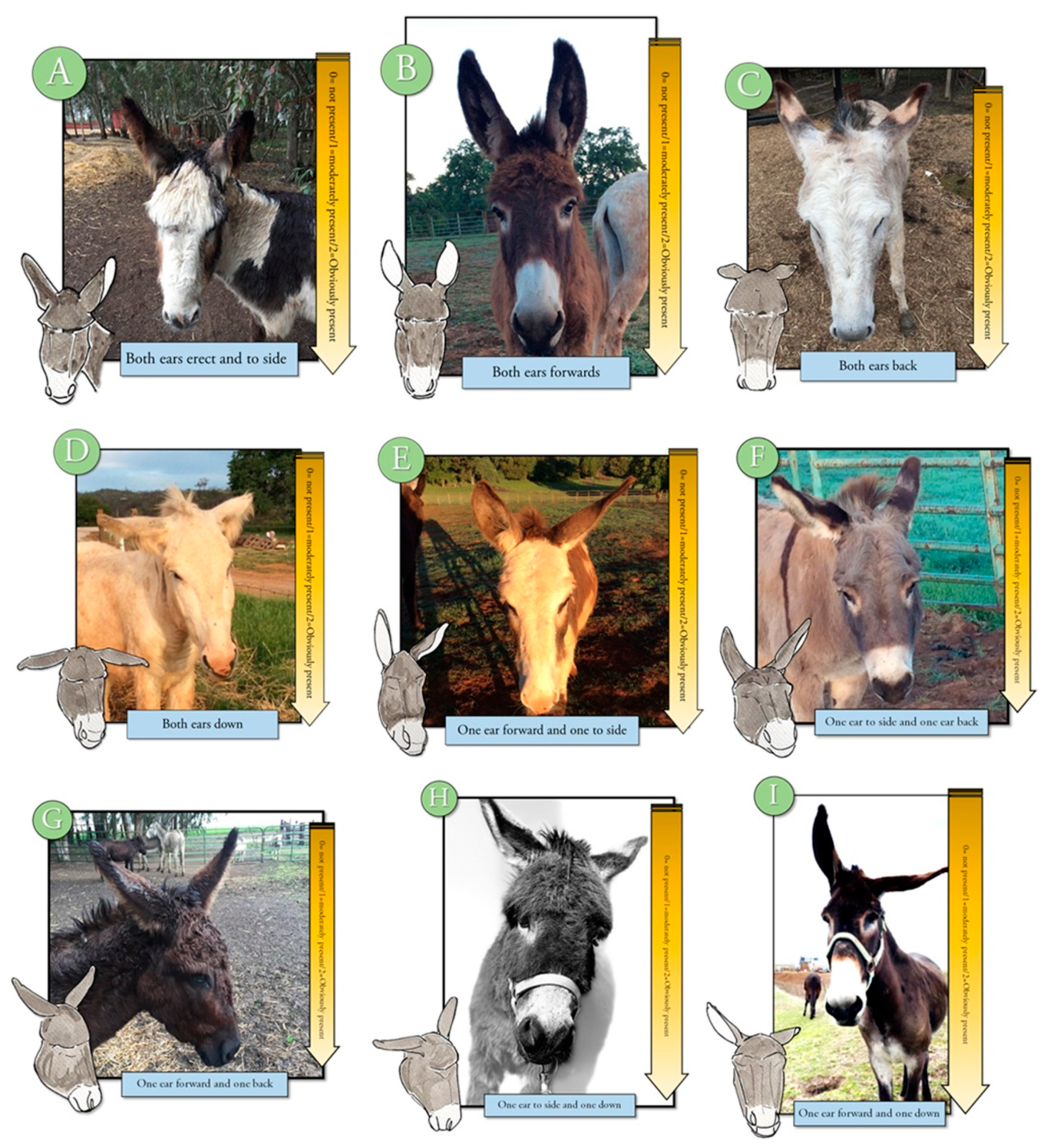
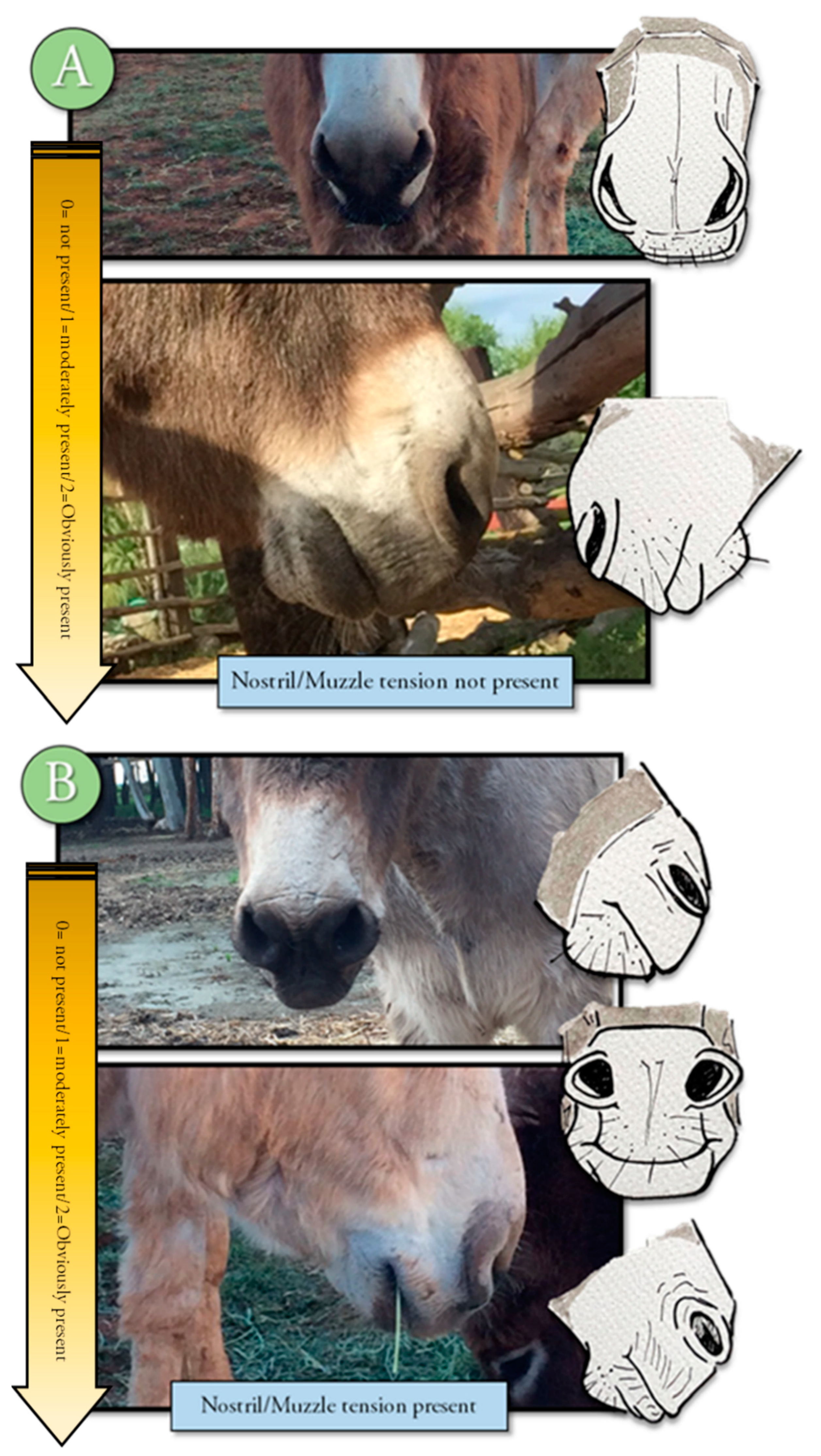
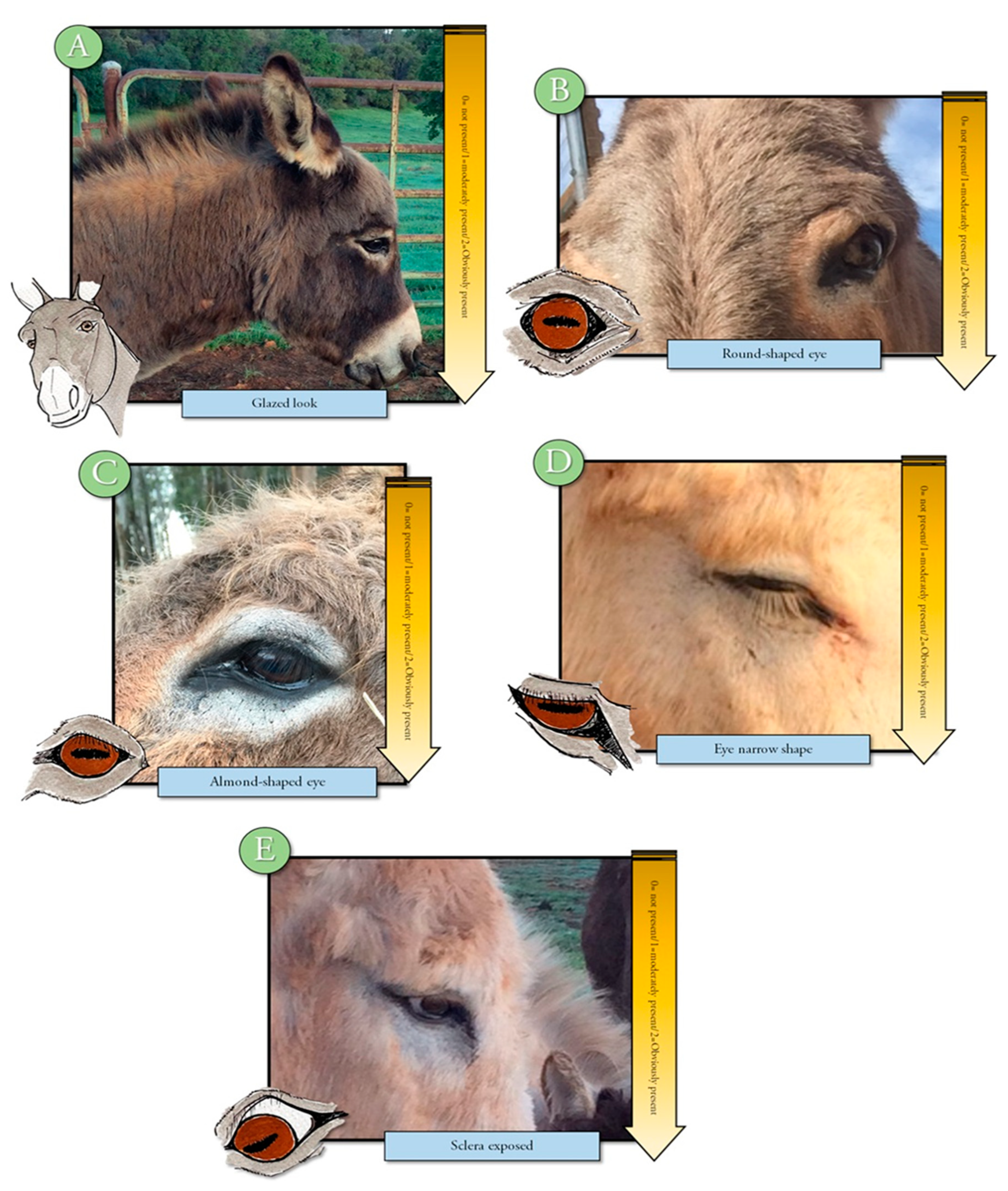
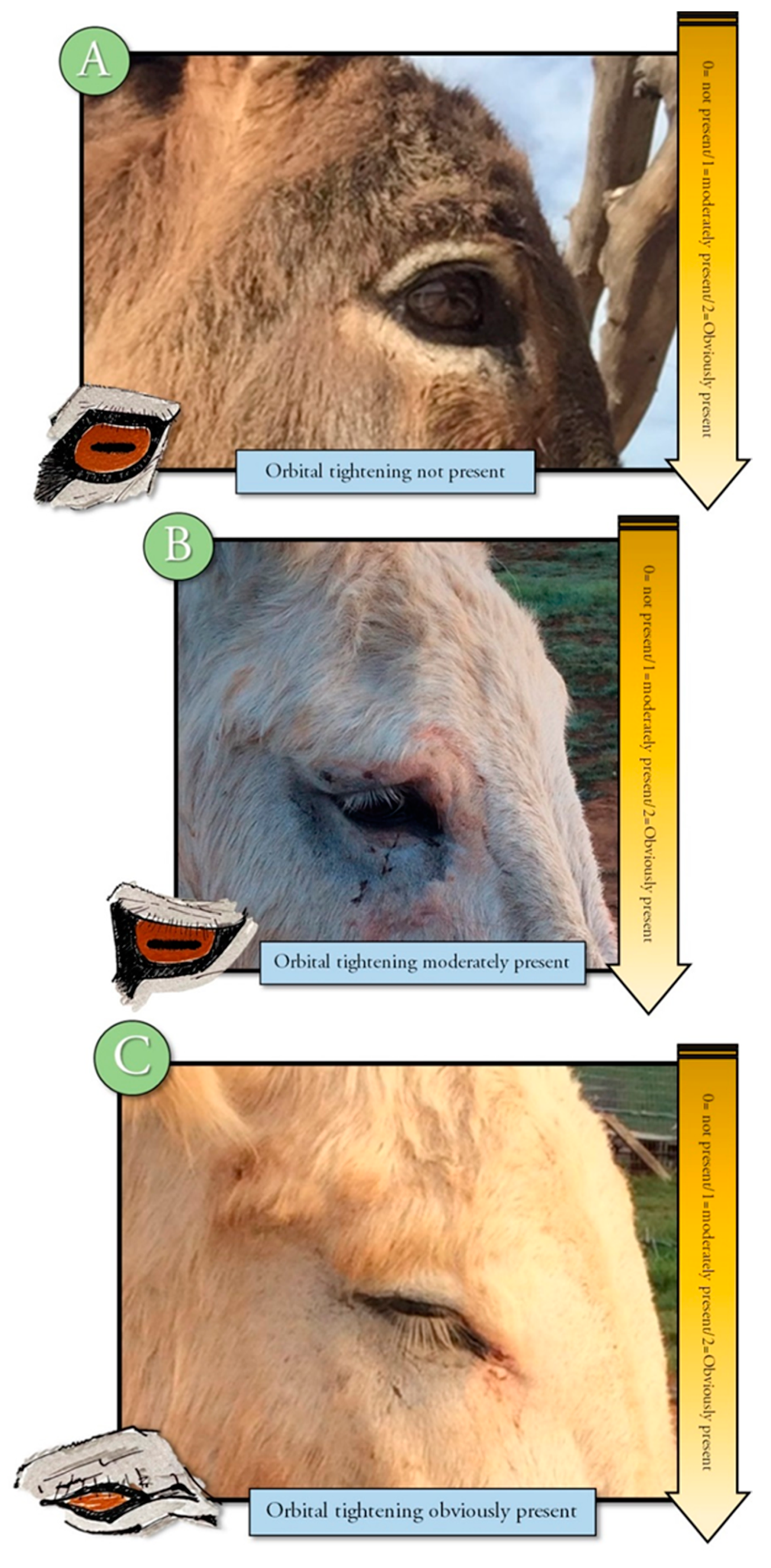
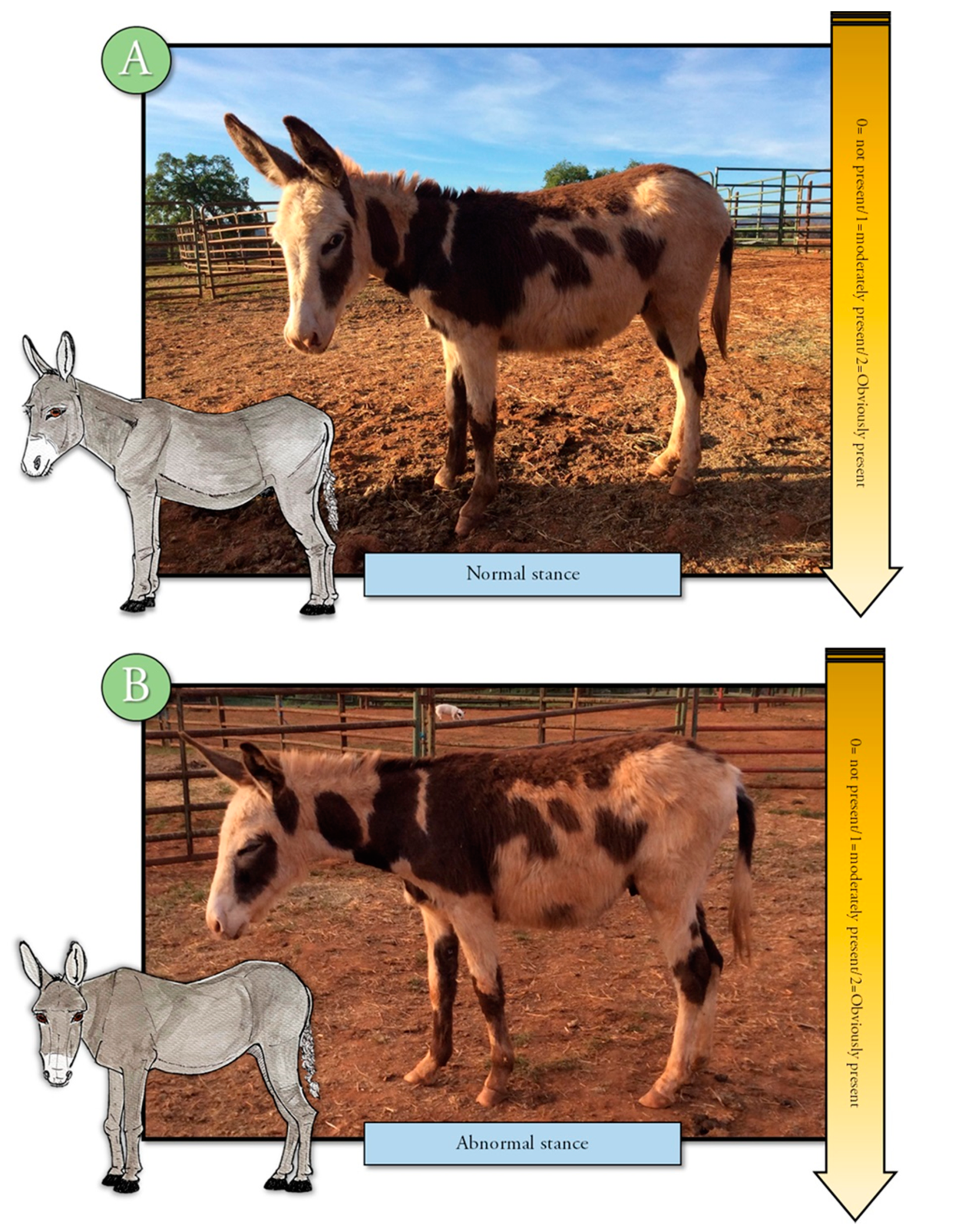
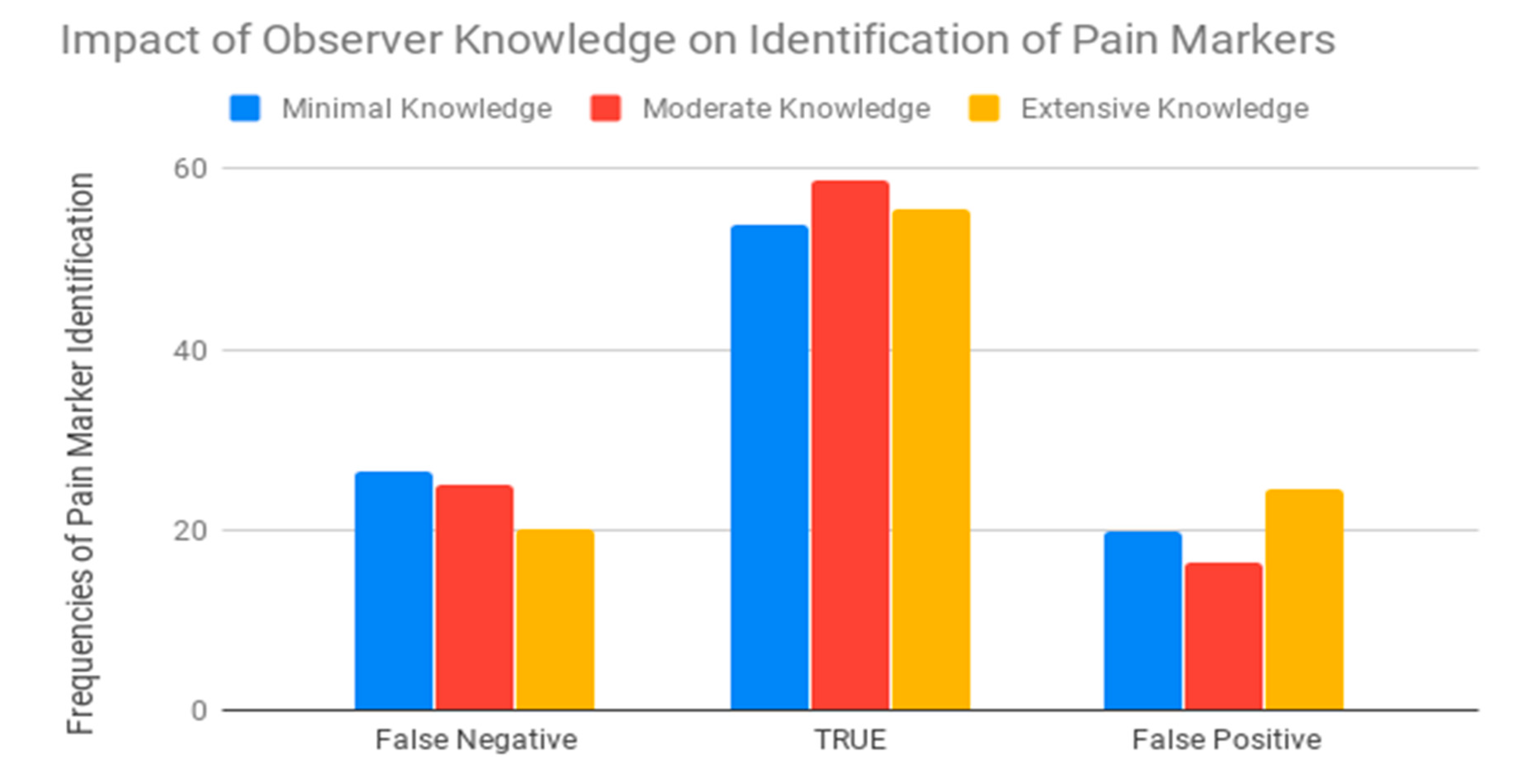
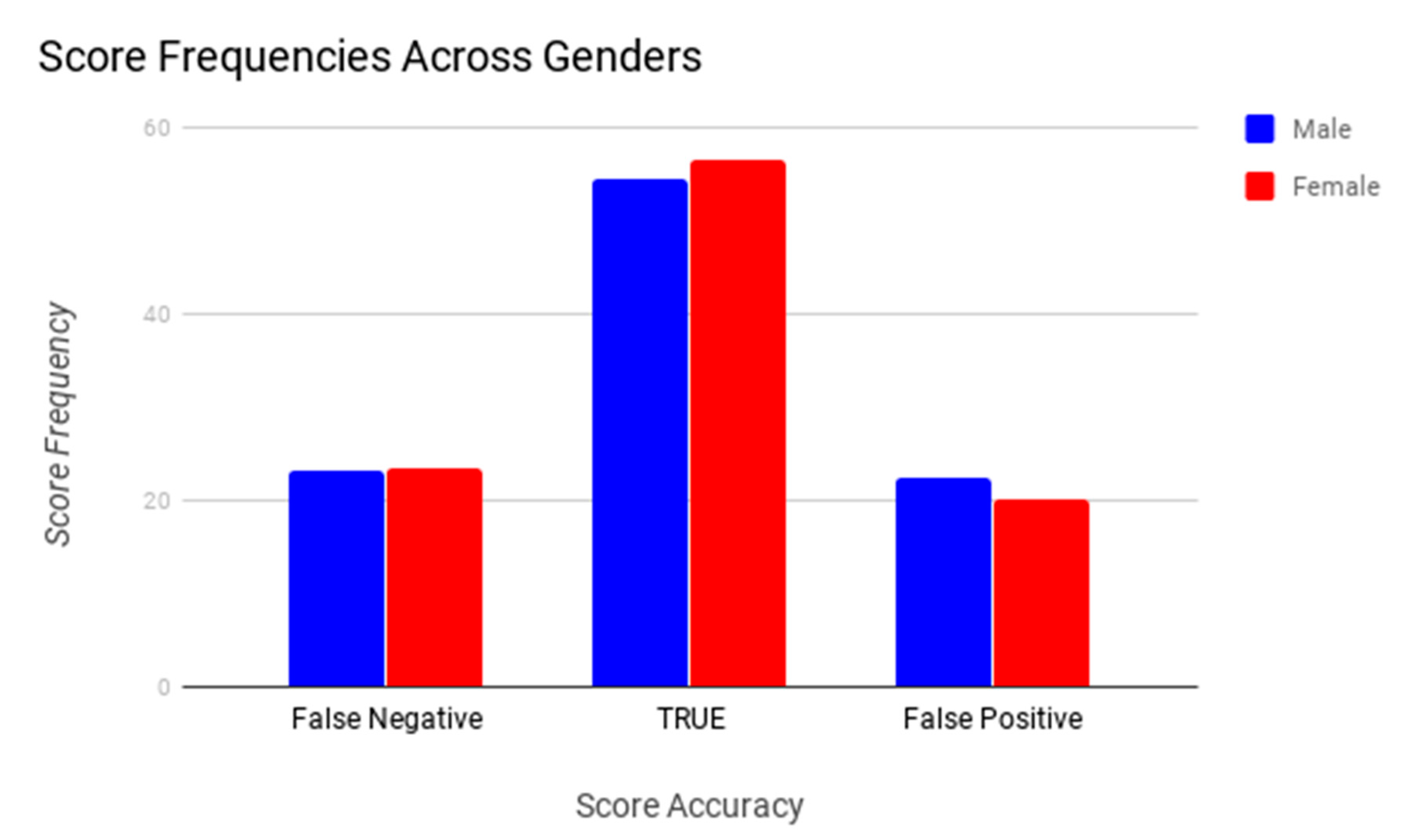
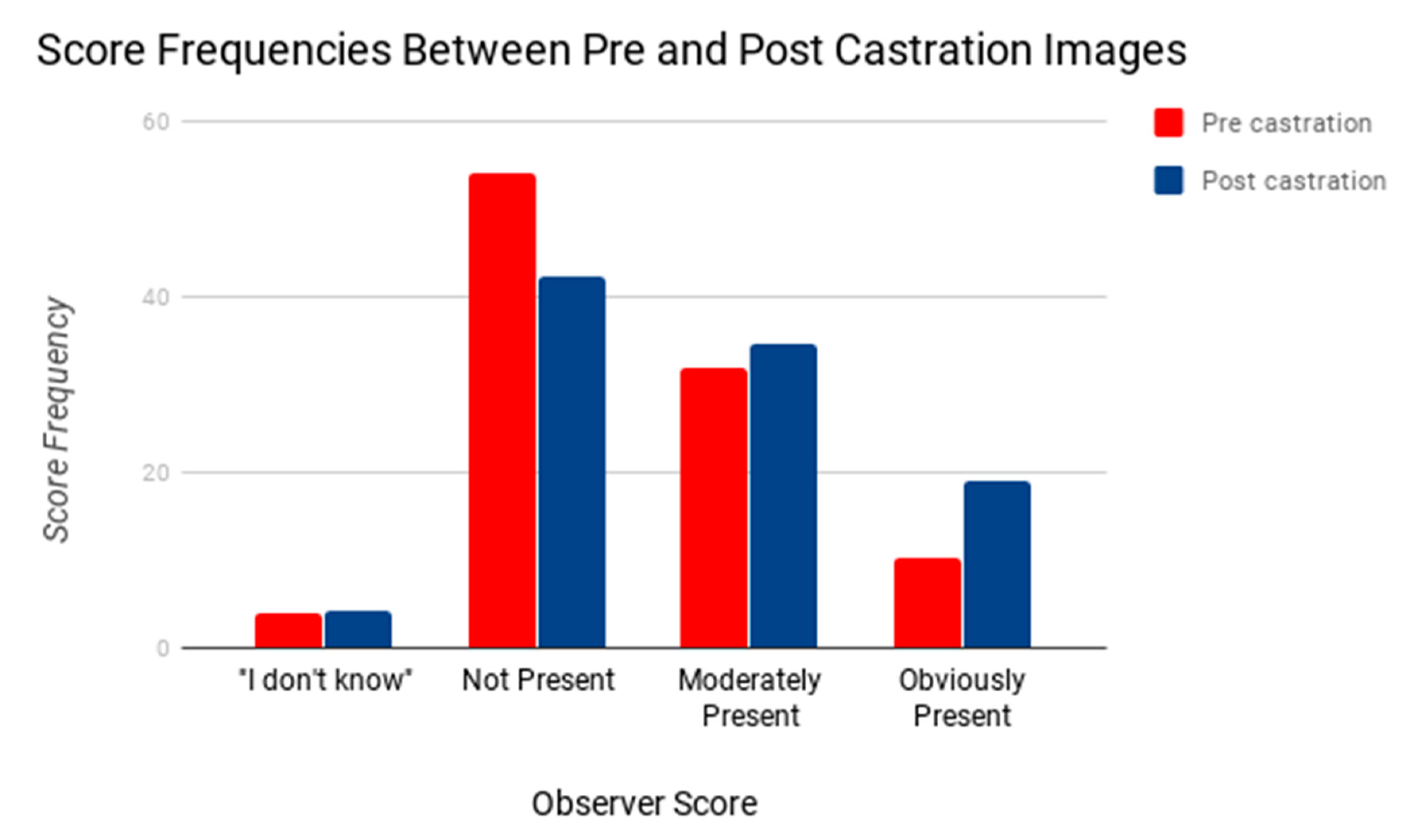
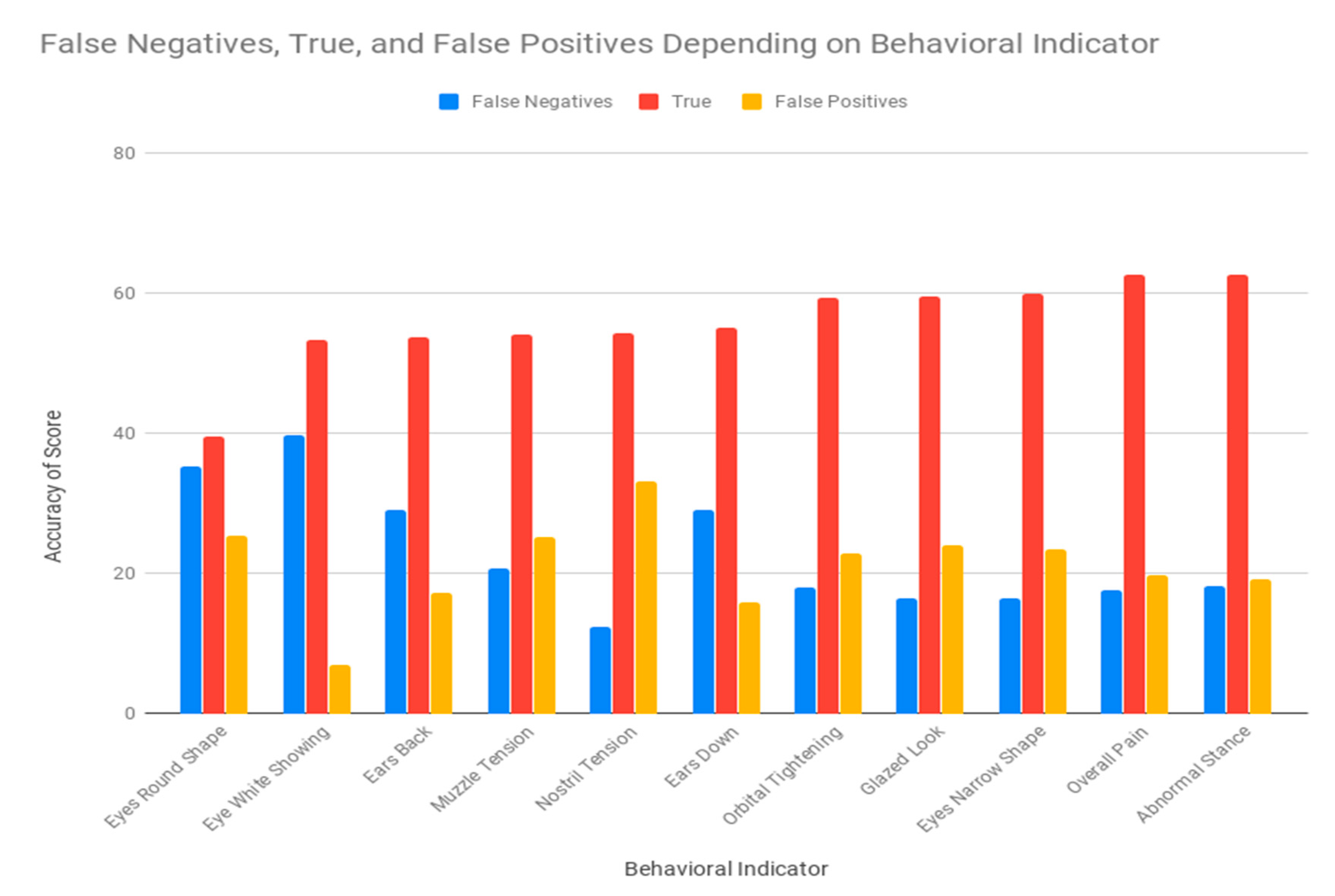
| Score Frequencies | I Don’t Know | Not Present | Moderately Present | Obviously Present |
|---|---|---|---|---|
| Pre-castration | 3.90% | 54.00% | 32.00% | 10.20% |
| Post-castration | 4.20% | 42.30% | 34.60% | 18.90% |
| Frequency differences | Value | df | Asymptotic p-value (2-sided) | |
| Pearson Chi-Square | 373.496 | 3 | 0.001 | |
| Sensitivity | Specificity | Accuracy | |
|---|---|---|---|
| Ears Down | 54.04% | 56.91% | 55.10% |
| Ears Back | 51.51% | 56.86% | 53.65% |
| Eye White Showing | 52.05% | 59.88% | 53.40% |
| Glazed Look | 61.18% | 58.26% | 59.50% |
| Orbital Tightening | 61.17% | 57.70% | 59.30% |
| Eyes Round Shape | 41.24% | 36.91% | 39.50% |
| Nostril Tension | 57.68% | 53.18% | 54.50% |
| Eyes Narrow Shape | 61.77% | 58.84% | 60.10% |
| Muzzle Tension | 54.51% | 53.76% | 54.10% |
| Abnormal Stance | 60.91% | 64.25% | 62.70% |
| Overall Appearance/Donkey Grimace Scale | 63.18% | 62.07% | 62.60% |
© 2020 by the authors. Licensee MDPI, Basel, Switzerland. This article is an open access article distributed under the terms and conditions of the Creative Commons Attribution (CC BY) license (http://creativecommons.org/licenses/by/4.0/).
Share and Cite
Orth, E.K.; Navas González, F.J.; Iglesias Pastrana, C.; Berger, J.M.; Jeune, S.S.l.; Davis, E.W.; McLean, A.K. Development of a Donkey Grimace Scale to Recognize Pain in Donkeys (Equus asinus) Post Castration. Animals 2020, 10, 1411. https://doi.org/10.3390/ani10081411
Orth EK, Navas González FJ, Iglesias Pastrana C, Berger JM, Jeune SSl, Davis EW, McLean AK. Development of a Donkey Grimace Scale to Recognize Pain in Donkeys (Equus asinus) Post Castration. Animals. 2020; 10(8):1411. https://doi.org/10.3390/ani10081411
Chicago/Turabian StyleOrth, Emma K., Francisco J. Navas González, Carlos Iglesias Pastrana, Jeannine M. Berger, Sarah S. le Jeune, Eric W. Davis, and Amy K. McLean. 2020. "Development of a Donkey Grimace Scale to Recognize Pain in Donkeys (Equus asinus) Post Castration" Animals 10, no. 8: 1411. https://doi.org/10.3390/ani10081411
APA StyleOrth, E. K., Navas González, F. J., Iglesias Pastrana, C., Berger, J. M., Jeune, S. S. l., Davis, E. W., & McLean, A. K. (2020). Development of a Donkey Grimace Scale to Recognize Pain in Donkeys (Equus asinus) Post Castration. Animals, 10(8), 1411. https://doi.org/10.3390/ani10081411






